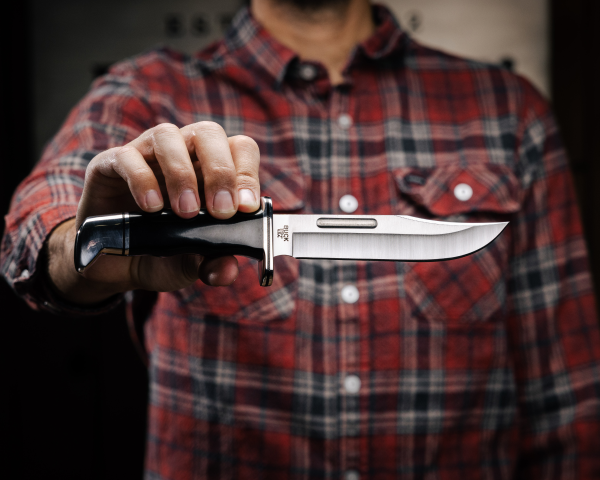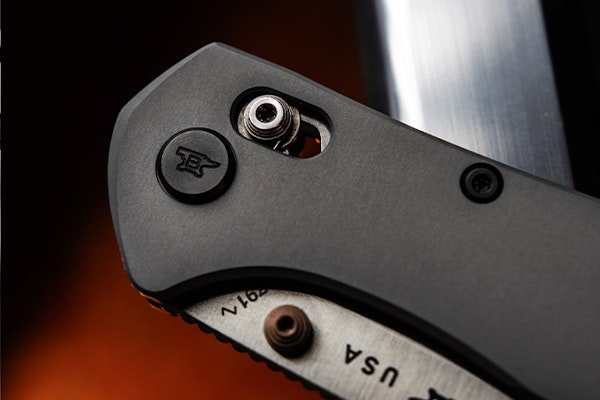What is the best knife blade shape?
That depends on what you are using the knife for. There are many shapes of knife blades available. Some were developed for specific tasks, while others are for more general use. Most blade shapes also include modified versions. This guide is intended to show some of the most common blade shapes and explain their intended purposes.
· Drop Point
· Skinner
· Clip
· Spear Point
· Guthook
· Tanto
· Caping
· Sheepsfoot
· Spey
· Coping
· Pen
· Serrated
Drop Point Blade

The drop point blade is generally full bellied with a strong, thick point for heavier tasks. The top of the blade drops down toward the tip, which provides good control for slicing.
What are drop point blades good for?
Strong and versatile, drop point blades are a great all-around blade. They can be used for many different tasks, and are frequently used as hunting knives, outdoor knives and everyday carry.
Skinner Blade

This blade shape was developed for skinning game. The tip is narrow, while the curved belly aids in getting through thick layers. Skinners are somewhat similar to the “Spey” blade—they are suited for skinning and sweeping knife strokes.
What are skinner blades good for?
Skinner blades work great for hunting. These tend to have an upswept, blunt tip to reduce the likelihood of puncturing hides or internal organs. The curved belly of the skinner knife also makes it a great camp knife that can handle food prep with ease.
Clip Blade

The front end of the blade is concavely clipped to make it thinner and sharper, which makes it good for detail work—piercing and cutting in tight places. The lowered point aids in control.
What are Clip Blades good for?
Clip point blades are ideal for hunting, the outdoors, and everyday carry as they work great on any task that requires absolute precision.
Spear Point Blade

Spear points have sharp, strong tips for piercing and may include a finger rest on top for detailed cutting control.
What are Spear point blades good for?
Spear point blades are made for survival and rescue situations where piercing with the knife is needed.
Guthook Blade

The guthook can be found on the top of the blade on some hunting knives or as a standalone tool. The hook hits the skin of an animal square and keeps the skin or hair from bunching up in the process.
What are Guthook blades good for?
Guthooks are a specialized blade for hunting ideal during the skinning process. This edge reduces the risk of puncturing internal organs. They can also be used for rescue situations such as strap cutting.
Tanto Blade

Designed to be very strong for heavy-duty use. Tanto blades hold up to piercing, scraping and prying with tough materials. Tanto is a traditional Japanese design with a heavier, stronger, angled grind from the edge to the tip.
What are Tanto blades good for?
Tanto blades excel in piercing tough objects. They usually feature a very tough/robust blade and tip. This makes tanto blades ideal for survival, and rescue situations.
Caping Blade

Almost scalpel-like in shape, it has a mild drop point, with nearly a spear tip that is used for the delicate removal of the hide of the face on a trophy animal. Caping knives tend to be slim and very light duty so they are not always a right choice if you only intend to carry a single knife.
What are Caping blades good for?
Caping blades are for detailed work on large animals, or for general work on birds and smaller game while hunting.
Sheepsfoot Blade

Sheepsfoot blades got their name from the shape of the point resembling the hoof of a sheep. With its distinctive flat, straight-line cutting edge and rounded point, it’s well suited to giving you a clean cut, especially on a flat cutting surface. The blunt, rounded tip is designed to avoid unwanted piercing.
What are Sheepsfoot blades good for?
Sheepsfoot blades work great as an everyday carry on a pocket knife due to its robust tip. Sheepsfoot blades are made for cutting, not piercing.
Spey Blade

As the name indicates, this blade was originally developed to neuter farm animals. A rather blunt point avoids poking through a surface by accident, and the overall blade configuration makes the spey function well suited for skinning and sweeping knife strokes.
What are Spey blades good for?
Spey blades are perfect for everyday task where a clean cut is needed.
Coping Blade

A narrow blade with a sharp, angular point, almost like a miniature sheepsfoot blade. It is designed to be used for cutting in tight spots or curved patterns, much as you would with a coping saw, only without the teeth.
What are Coping blades good for?
Coping blades are great at cutting through fabric like clothing or carpet. Originally designed for carpentry work.
Pen Blade

This is a smaller version of the larger spear point blade. Pen blades are usually on pocket knives as a handy, all purpose blade. It was originally developed to trim quill pens, and that name has stuck through the years.
What are Pen blades good for?
Pen knives are perfect for detailed task like sharpening a pencil.
Serrated Blade

Serrations, which might be considered a “semi-saw,” provide a more aggressive cutting action, especially useful when cutting wet line, cord or cable. The serrations also retain their ability to cut longer than a standard edge. Select blades are now offered with partial serrations, providing the benefits of both cutting actions.
What are Serrated blades good for?
Serrated blades are great for any situation where you are around rope, line, cord, or cable. Serrated blades can be lifesaving in marine environments and rescue situations. Also great for kitchen cutlery like steak knives.




